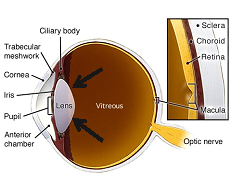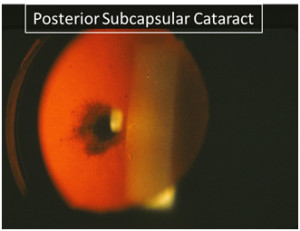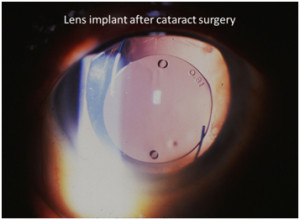 Cataracts is the most common ocular disease that results in decreased vision, usually occurring as part of the normal aging process of the eye. Inside our eyes, we have a clear, round lens that is used to focus light onto the retina, allowing for clear vision. When this lens is clear, the light entering the eye passes through it unobstructed. Over time, this lens becomes cloudy, resulting in two things. First, the amount of light that is able to pass through the cloudy lens is decreased, which results in decreased vision and the need for more light when reading. Second, the light that is able to pass through the cloudy lens bounces off the cloudy areas and is scattered, again resulting in decreased vision and glare. Common symptoms that are observed when a person has a cataract include: generalized blurry vision, glare at night, difficultly seeing to read books, and having to use more and brighter light to read or see at near.
Cataracts is the most common ocular disease that results in decreased vision, usually occurring as part of the normal aging process of the eye. Inside our eyes, we have a clear, round lens that is used to focus light onto the retina, allowing for clear vision. When this lens is clear, the light entering the eye passes through it unobstructed. Over time, this lens becomes cloudy, resulting in two things. First, the amount of light that is able to pass through the cloudy lens is decreased, which results in decreased vision and the need for more light when reading. Second, the light that is able to pass through the cloudy lens bounces off the cloudy areas and is scattered, again resulting in decreased vision and glare. Common symptoms that are observed when a person has a cataract include: generalized blurry vision, glare at night, difficultly seeing to read books, and having to use more and brighter light to read or see at near.
 There are many different kinds of cataracts such as: nuclear sclerotic cataracts (the most common), cortical cataracts, posterior subcapsular cataracts, anterior subcapsular cataracts, traumatic cataracts, and congenital cataracts. There are also multiple causes for cataracts. The most common cause is the normal aging process of the eye. Other causes include trauma (either from injury or as a result of ocular surgery), medical conditions such as diabetes, and even the use of prescription drugs such as steroids. The degree of visual problems that a cataract causes is widely variable – from no effect on vision, to complete blindness.
There are many different kinds of cataracts such as: nuclear sclerotic cataracts (the most common), cortical cataracts, posterior subcapsular cataracts, anterior subcapsular cataracts, traumatic cataracts, and congenital cataracts. There are also multiple causes for cataracts. The most common cause is the normal aging process of the eye. Other causes include trauma (either from injury or as a result of ocular surgery), medical conditions such as diabetes, and even the use of prescription drugs such as steroids. The degree of visual problems that a cataract causes is widely variable – from no effect on vision, to complete blindness.
Treatment of Cataracts
Depending on the degree of visual compromise a cataract causes, treatment ranges from observation to surgical extraction. When a cataract decreases vision to the extent that it interferes with a person’s quality of life, surgery is recommended to remove the eye’s cloudy lens (cataract), and replace it with a clear man-made prosthetic lens (lens implant). This process is referred to as “cataract surgery”. Cataract surgery is the most frequently performed outpatient surgery in the United States, and it is usually a quick and painless procedure with a low risk for significant complications. The  vast majority of surgeons will perform cataract surgery under local anesthesia, meaning that the patient is awake throughout the entire procedure. Recovery is usually rapid, and post-operative management includes the use of eye drops that decrease the risk of infection as well as control the inflammation caused by the procedure. The standard post-operative period during which a patient is monitored is usually one month. During this post-operative period, a patient will be using eye drops and be required to present to the co-managing doctor from time to time in order to check on the healing process.
vast majority of surgeons will perform cataract surgery under local anesthesia, meaning that the patient is awake throughout the entire procedure. Recovery is usually rapid, and post-operative management includes the use of eye drops that decrease the risk of infection as well as control the inflammation caused by the procedure. The standard post-operative period during which a patient is monitored is usually one month. During this post-operative period, a patient will be using eye drops and be required to present to the co-managing doctor from time to time in order to check on the healing process.


